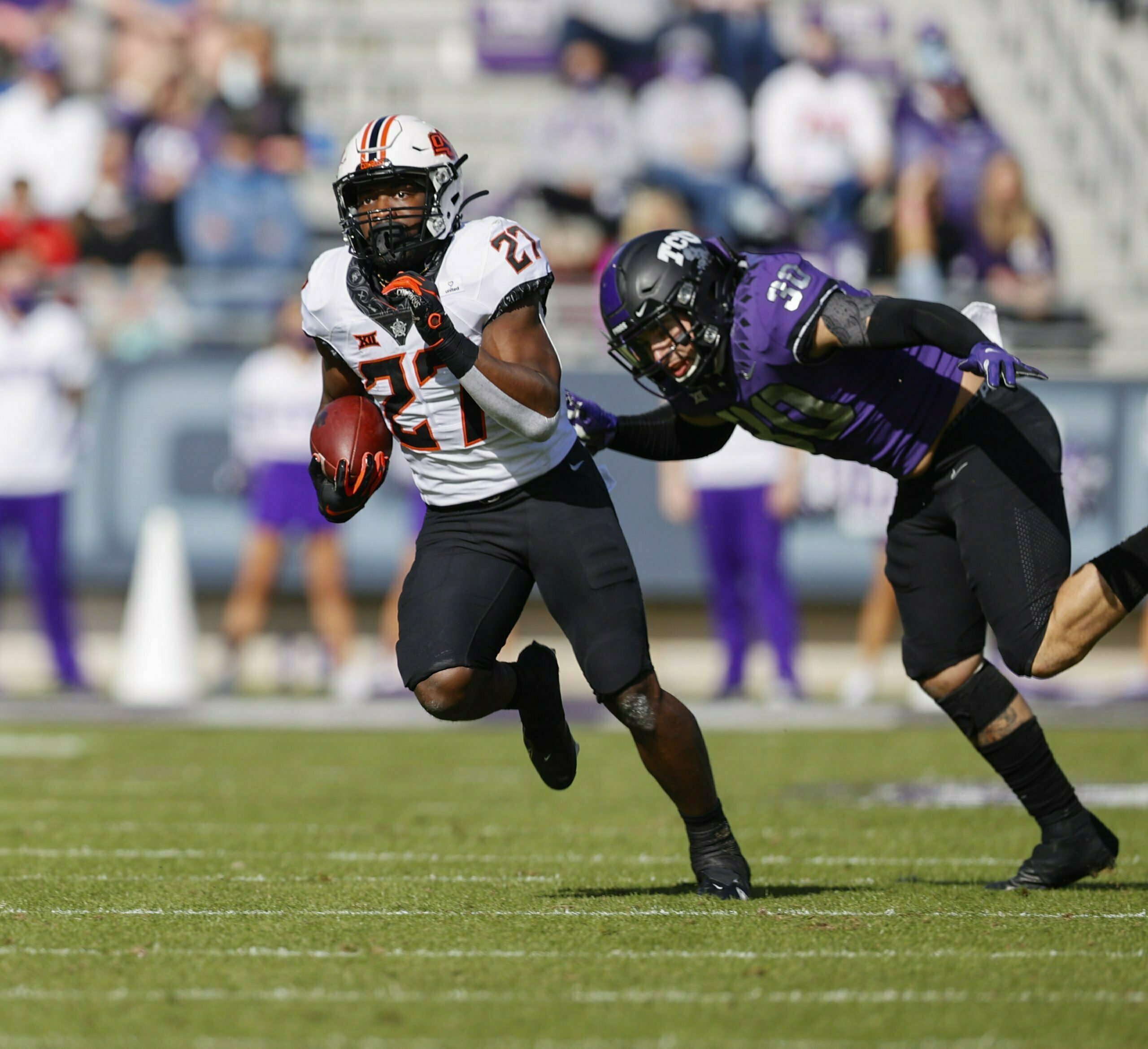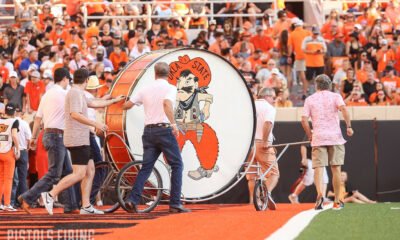Football
PFB+ Film Study: A Look at OSU’s Offense in Loss to TCU (Part 2: Rushing Attack)
Part 2 of our 3-part series reviewing the TCU game.

Yesterday in part one of my three-part offensive film review of the TCU game, I took a look at the overall scheme. Today, I’ll dive into the Cowboy running game.
Rushing Attack
Dez Jackson and the Zone
In OSU running back Dezmon Jackson’s breakout performance against Tech, he gained a lot of yardage when the Cowboys ran Outside Zone.
On outside zone plays, the offensive linemen take a bit more of a lateral first step and try to reach the defender across from them. He wants to get his body between the defender and the sideline. It’s important to note, however, that the very act of trying to reach the defender often gets him flying to the sideline, at which time the offensive lineman can then switch to driving the defender to the sideline. The running back aims for a point outside the tight-end, though he can cut it upfield wherever a seam appears.
Once the defense begins flowing too fast to the sideline, coaches typically dial-up the inside zone. The rules are the same — covered and uncovered — except this is more of a drive block as the aiming point for the running back is inside. The play often results in a cutback if the defense is flowing fast for the outside zone, but the difference between the outside zone is one of technique, not assignment. And, again, it does not make a difference to the linemen (or at least not much of one) if OU runs this from a four wide set or a two-back one.
[SmartFootball.com]
Against TCU, Jackson was able to again find success with this play, as you’ll see in the following example.

As explained in the video above, the Pokes overloaded the left side of the field with a “bunch” formation and the running back aligned to that side. However, they then ran to the right side, or the wide side, of the field. With the defensive backs on that side having to pay attention to talented wide receiver Tylan Wallace and some solid blocking from the offensive line, a running lane was created for Jackson.
Next we see the Cowboys overload the boundary, or the short side of the field, but this time they run Outside Zone to the boundary instead of the wide side.
Offensive coordinator Kasey Dunn also found some success with Split Zone, in which the Cowboy Back blocks across the formation, as you’ll see in the next clip.
However, as the game wore on, TCU started adjusting to the zone running scheme, and with the scheme lacking some creativity, as I mentioned in yesterday’s post, it became less and less successful. In the second half, Jackson didn’t have a single rush that went for over four yards, but Dunn continued to feed it to him in the zone scheme, even when the Horned Frogs stacked the box.
Power
Outside of the zone running game with Jackson, OSU had some nice runs utilizing Power. The Power blocking scheme normally involves a lineman pulling around to the play side to lead block through the hole. This is different from a zone run in that the offense’s point of attack is predetermined.
In the play below we see the backside guard pull around to the playside and lead block through the hole. The front side of the line, including the Cowboy Back, blocks down, or away from the playside. In addition, you see the left tackle will leave his down block of the defensive lineman and work to the second level to block a linebacker.

With the down blocks from the playside O-linemen and the pulling guard from the backside, Power creates different angles and new gaps for the offense that the defense isn’t always expecting. The Pokes were able to pick up a couple of decent gains on Power early in the first half, but when they tried to go back to it late in the second quarter and in the second half, TCU’s defense had made adjustments and wasn’t fooled.
Zone Bluff
As I mentioned above, split zone is a variation of the zone blocking scheme where the extra blocker, the Cowboy Back for OSU, blocks across the formation, against the flow of the play. This play causes confusion for the defense, as the Cowboy back is blocking one way but the play is going another way, and it can also create a cut back lane for the ball carrier. Here’s a diagram of what this play normally looks like.

As you see in the above image, this block by the Cowboy Back (or H-back in the picture) allows the right tackle to move up to the second level and block a linebacker. It also allows this tackle to assist with double team blocks if the defense has a dominating defensive lineman on their squad. We’ve talked about this play in previous posts, as it’s been a staple of the Cowboy running game this season. The Pokes didn’t utilize it as much against TCU as they have in prior contests, but we did see it some on Saturday.
In addition, in the second half against the Frogs, OSU started to incorporate the QB running game a little more with zone bluff. On this play, the Cowboy Back will “bluff” the split zone block shown above. By “bluff,” I mean he will go around the backside defensive edge player (defensive end/linebacker) and take the first defender on the outside. See the play below for more detail.

Spencer Sanders two biggest runs of the game came on this play, as you see the second one below.
You can see in both videos the TCU safety (#20) get blocked inside, in the first video by Cowboy Back Jelani Woods and in the second video by wide receiver Landon Wolf, allowing Sanders to have an open running lane on the perimeter.
The split zone and zone bluff worked really well against TCU last season, as you’ll see an example below, and I was surprised Dunn didn’t go to it earlier and more often in this one.
Running back Chuba Hubbard and Sanders combined for 311 rushing yards against the Horned Frogs in last year’s matchup, and there were a lot of big gains on this concept.
For the final installment of this film review, I’ll take a look at the passing game.

-

 Wrestling4 days ago
Wrestling4 days agoThe Top 5 Quotes from John Smith’s Retirement News Conference
-

 Football5 days ago
Football5 days agoWide Receiver Prospect Kameron Powell Commits to Oklahoma State
-

 Hoops5 days ago
Hoops5 days agoReport: Former Arkansas Guard Davonte Davis to Visit Oklahoma State
-

 Wrestling4 days ago
Wrestling4 days agoOSU Wrestling: The Impact John Smith Had on His Final Boss, Chad Weiberg





